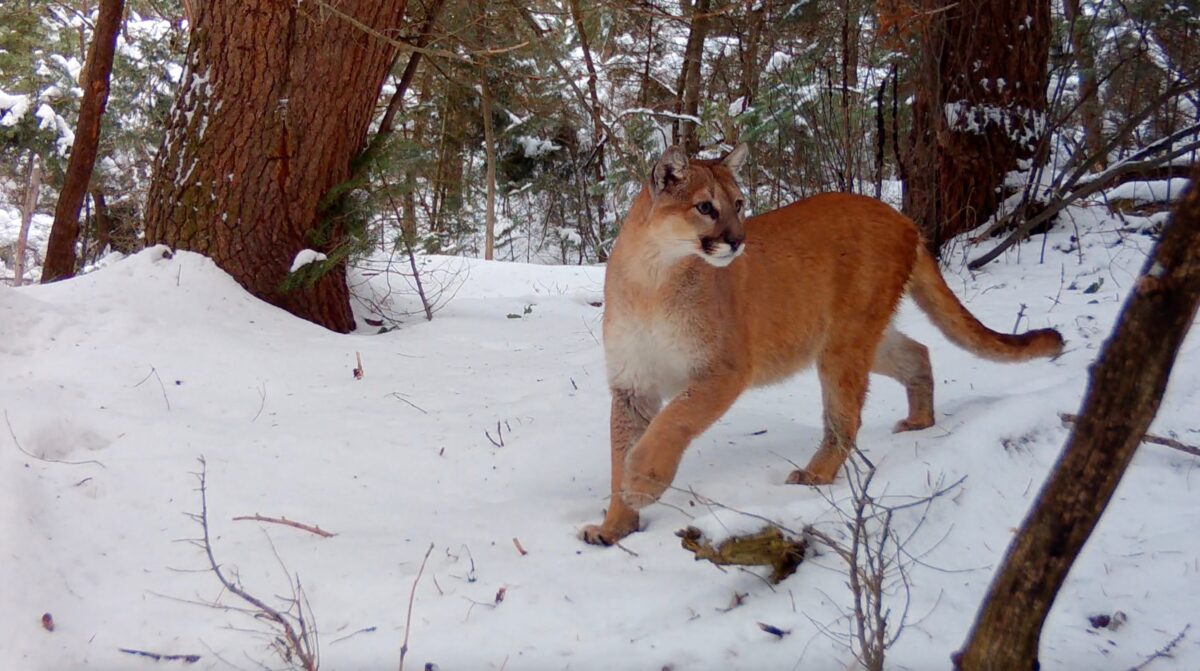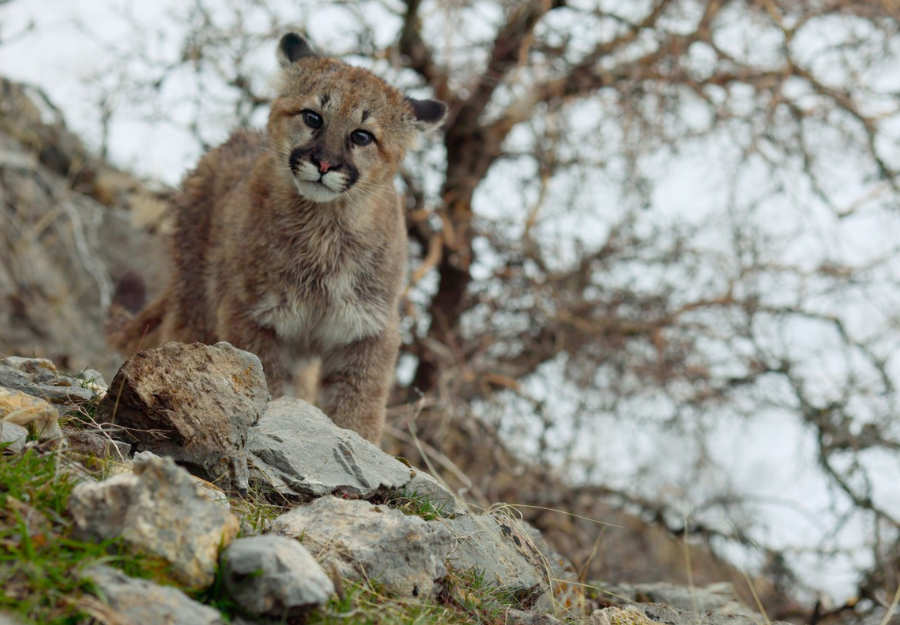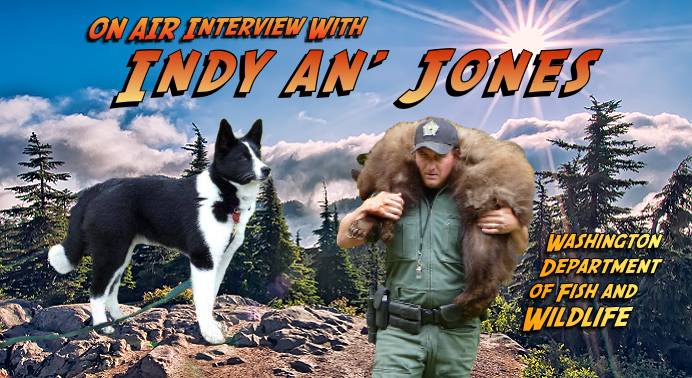
On Air with WDFW Officer Jones
An Audio Interview with Julie West, MLF Broadcaster
 Listen Now!
Listen Now!
Listen to the interview from MLF’s ON AIR program, podcasting research and policy discussions about the issues that face the American lion.
Transcript of Interview
Intro: (music) Welcome to On Air with the Mountain Lion Foundation, broadcasting research and policy discussions to understand the issues that face the American lion.
Julie: This is Julie West with the Mountain Lion Foundation. Today’s guest is Officer David Jones. David is a game warden with the Washington Department of Fish and Wildlife.
Born and raised on the east coast, he graduated from the University of Massachusetts in 1992 and moved to Washington in 1994. In 1995, he started his WDFW career as a hatchery worker for Cedar River Hatchery and additionally worked for other hatcheries until 2002, including Soos Creek, Bird Creek, and Merwin.
In his current role as game warden, Jones serves Washington citizens by overseeing laws relating to fish and wildlife, resolving conflicts between humans and wildlife, and forming partnerships with the public and other agencies to benefit fish and wildlife.
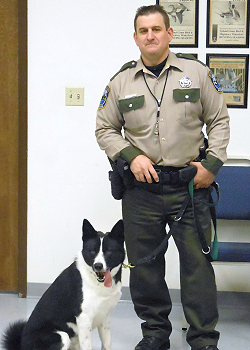
In 2007, Washington Department of Fish and Wildlife began a pilot program to use Karelian Bear Dogs to resolve conflicts between humans and wildlife. Officer Jones is paired with the Bear Dog, Indy, and together they address a number of public safety and wildlife issues. He’s here with me today. Thank you so much, David, for joining me.
Officer Jones: Thanks for having me, Julie.
Julie: Karelian Bear Dogs have been proved effective for deterring and repelling bears as a non-lethal wildlife control strategy, and the Washington Department of Fish and Wildlife are now using them to deter mountain lions as well. Why don’t you give us a little history. Tell us what led to that decision.
Officer Jones: What we decided to do: we have some ongoing projects regarding collaring some cats and having some biologists that are working on it to bring a little more science to it, a little more data which a lot of folks often want.
For now, the stage we’re at is the dogs were primarily envisioned as dogs for working with bears. We’ve had a number of issues regarding cat conflicts, showing up in the same place the bears are showing up. The activity’s a little different. Not so much getting in the garbage, but getting some deer or getting elk, which is what their supposed to be doing. But often times that brings them a little bit closer to society. I look at it as — we as a team, all the folks that have dogs — look at it as another tool how best to deal with these cats.
What we do with these dogs, and it’s the same idea what we do to the bears, we do what we call “hard releases.” There’s a couple different ways of doing the “hard release.” One is the traditional way of removing the animal from the area and bringing it up to an area where we hope that it’ll stay. Of course, they’re a lot of factors that dictate whether that a cat or bear will stay where we put them based on quality of habitat and is there a dominant animal already in the area. Those are things that we don’t always know. Of course, there is science there but there is also a little bit of art and some luck thrown in there as well.
What we do is: choice one is you trap the cat, and you bring it out to an area where you’re hoping it will stay, within reason, and you release the cat in that area. Of course, when we do that we do some rubber bullets, bean bag bullets, some cracker shells, and we have the bear dogs there that are agitating the cat.
What we’re trying to do is just make the cat’s experience with us as unpleasant as possible and with the hopes that it’s going to minimize contact with humans in the future. So you keep the dog attached to you, and the dog is barking at the cat the whole time. Then once you release the cat, you do some pyrotechnics and some bean bag stuff. They hear the dog barking, and the hope is they don’t like it.
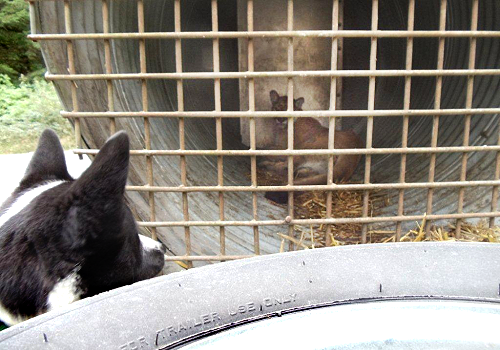
Julie: Got it. And so the cat will, I guess, just run into the area. Is there any effort to track it or to monitor it to make sure it’s not coming back?
Officer Jones: Right. So what we have, we have two different things. The biologist, they have about ten cats, the gentleman’s name is Brian Kertson. He’s kind of the lead on the project. His job is to find some cats down in Kings County, and put collars on them and literally track through GPS what these cats are doing. Where they are going, how often they’re going places and how much time they spend and where they spend it. That’s a very science based approach.
What we’re doing with our cats, we don’t always have time to put GPS collars on them. As a matter of fact, generally we don’t have the time, so we put a tag in their ear. While we cannot track where they’re going, if they do in fact show back up, we at least know that, okay, this cat has a tag in its ear and it’s shown up somewhere before. That helps us to track them a little bit
Julie: Obviously dogs typically bark at and are prone to chase cats, but why this breed? What is it about this breed that makes them so suited for the job?
Officer Jones: Every dog has a different personality, folks need to understand that. All these dogs are matched with their handlers. Apparently mine is full of energy and stubborn, and I’d have to agree with the breeder that that dog is, in fact, exactly like its owner.
I’ll give you a general sense. These dogs are fearless. They’re not generally afraid. They’re aggressive in the sense that towards the animals, they’re not afraid of them. They’re aggressive, they’ll bark, they’ll chase them. But then when you bring them out into society, with folks, with people, they can dial it back down, because our dogs spend an awful lot of time around kids and people. You need a dog that can dial it up when it’s dealing with animals. Then you need the same dog to dial it back down when it’s dealing with the folks. That’s something that we like.
The nose on these dogs are incredible. The challenge I have is deciphering what it is he smells. Is it bear scat verses a bear. That’s something he and I will probably be working on for years. He has to know what it is I’m looking for, so that’s a bit of the challenge that I have with him.
The energy level, the fearlessness, the loyalness, the desire to want to hunt which is what they were bred to do out of Finland, was to hunt. The challenge here is, as opposed to historically where the dog was released and could take off for miles and track down the object of the hunter’s desire, I need my dog to stay closer to me because if he goes off too far, that’s not really helpful. Hopefully, I’ve articulated some of the things that we are looking for in these dogs.
Julie: Yeah. They’re not working in packs or with another dog. Individually they bring those traits that are needed to deter a large predator.
Officer Jones: Yes. Historically they would hunt on their own, and most of the time with the handlers, they’re hunting and searching on their own. There are occasions where they will hook up with some hound dogs and work with the hound dogs a little bit more. We may actually get all our dogs together or maybe two dogs together, but that is probably less then ten percent. So, you’re correct. Generally, the vast majority of the time, they’re working on their own.
Julie: In some states, the mountain lion is considered to be a predator that can be shot on the spot regardless of circumstance or proven threat. So, how does the Washington Department of Fish and Wildlife manage cougars differently from other states, number one? And number two, what are some of the measures in place when dealing with an unwelcome predator?
Officer Jones: The best thing my dog does for these cats is education. Beyond the fairs and the school meetings, and the Hunter Ed classes, we know we can actually touch a group of 20, 30, maybe 50 people at a time. Sometimes on T.V. you can reach hundreds of thousands.
But it’s at a local level where folks insist that any time an animal in the neighborhood dies, that it’s got to be a cat, where the vast majority of times in this neck of the woods, it’s coyotes that do a lot of grabbing the farmer’s animals. What this dog does is — I can bring it to the scene and I can, based on the evidence I see — no different then a crime scene. And based on the way my dog is acting, it can help indicate whether there was a cat responsible for that kill or not, and thus I educate.
And usually when it’s more than one animal where people are coming over and the neighbor is coming over, you can actually educate whole blocks of people just by going out and visioning a kill-site. That’s one of the biggest things, if I’m answering that question right, that my dog does as far as I’m concerned.
Julie: How interesting. I was focused more on the deterrent itself, but you’re saying there is a little sleuth work involved. Their using their K-9 skills to act actually help determine if the cat was the killer in the first place.
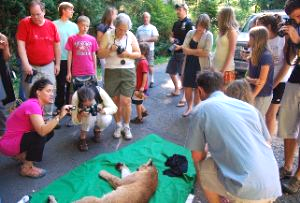
Actually, there’s a whole other area that my dog is touching on and all these Karelian Bear Dogs touch on. Every county’s a little different, every community’s a little different. What folks expect in eastern Washington as apposed to western Washington is going to be a little different, every county is a bit different.
To answer your question — it may have been a backward approach — but in the state of Washington, you have to articulate that there is some sort of fear. Either you are afraid for livestock, animal, yourself, or family member. Then based after my investigation — an officer has to investigate it — was it all right to shoot him. We have open seasons for the cats, and we have some permit situations where we give out if there’s a nuisance cat that’s causing an awful lot of trouble. We’ll get some hound hunters out and try to remove the cat if we can. Or I can use whatever it is that cat has killed, generally it’s a deer, goat, or a sheep, and I can use that to capture it in a trap.
Generally, I remove the cats without killing them. It’s non-lethal to the best of my ability. Occasionally, we do have to euthanize them, but for the most part I try give the cats the benefit of the doubt. It’s a bit of a referee balancing act. You have to weigh public safety, versus the cat being released. I’m coming in the backdoor on your question, but for me, it’s the education portion of it, because when one neighbor says there’s a cougar that killed my sheep, that spreads like wildfire. Now eight people know it, and 28 people know it, and 108 people know it, and it’s false information.
Julie: They all want that cat dead as a result of it.
Officer Jones: Generally they do. They want the cat removed. I guess they don’t so much care if it’s dead or not. They just want it gone. And nine times out of ten, it’s not even a cat. Now, on occasion, it is a cat. It’s not that it doesn’t happen, it does, and I do my best to handle the situation. But generally, a vast majority of the time, it’s not even a cat. So that public information, trying to get the cougar off the public enemy list is a little bit strong but it’s always the boogey man, right? It’s always the cougar. So that’s what Indy does, and that’s what I try to do is kind of disprove some of these falsehoods that gets spread awfully quick in some communities.
Julie: Now, you mentioned your dog’s name, Indy, just now. Tell us about your partner, Indy. You mentioned that he was stubborn.
Officer Jones: This character here, he is a small dog. He’s on the small size, mid 50’s, full of energy, fast as can be, intelligent, an incredible nose. But if you don’t keep an eye on him, he’ll be two counties away in a very short period of time. You have to keep an eye on him. He is high energy, and because of his nose and because — he’s only 16 months old, he’s going to spend three to four years — because he rides with me every day. We do a little bit of training. I wish we could do more training. Most of his training is on the job: Where’s the animal? Let’s go figure it out. Let’s handle this. He doesn’t get as many classes as I like to give. The breeder gives him some initial instruction which is very helpful.
He’s versatile. Helps with bears, deer, elk, cats. He helps with all kinds of different things. The challenge, especially as a young puppy, is for me to understand what he is reacting to. When we go to a kill site, he’s going to react to the smell of a coyote. He’s going to react to the scat. Number one, he needs to learn that I don’t care about those things; and number two, I need to learn to read what it is he’s seeing.
When he sees a cat or a bear, something of imminent threat, the hair raises right up on his back, like a ridgeback hog. He gives me a visual, which is helpful. I can tell by the way he’s acting if there is something in the immediate area. But that’s something that’s going to be honed over years and years and years of him and I hanging out, so he’s a great partner to have.

He does a lot more than people think as far as finding poached animals and those types of things that they don’t get credit for. He’s a good partner to have. The folks out in the field realize that it’s kind of a two-man team, it’s an officer and a dog, not just an officer so he’s all around helpful. He is time consuming, and he takes energy out of me because he’s so full of energy, but he’s a good partner to have.
Julie: I’m so glad. And the Wind River Bear Institute has partnered with the agency. How did that partnership come about, and are they the ones actually training the dogs?
Officer Jones: Right. That’s Carrie Hunt who is over there in Montana, and that relationship initially started about eight to ten years ago. We had a biologist named Rocky Spencer who had a tragic accident several years ago with a helicopter. He’s no longer with us. He was dealing an awful lot with problem wildlife, and he was looking into some options. There was a biologist that worked for the forest service that he bumped into, and she had a Karelian Bear Dog.
So he just kind of back tracked where that dog came from, and wound up talking to the folks at Wind River Bear Institute. That’s how the relationship started. He was the first one, a biologist, to have one of these dogs. When he passed away, that dog went to one of our enforcement officers. The program has grown a little bit to six dogs total since then. That’s a little bit about how that got set up.
Julie: I guess within your enforcement network, and assuming that non-lethal is the goal, your colleagues will know to call you or to call one of your other partners with a dog if there are instances where the dog is needed.
Officer Jones: Yes, that is absolutely correct. We have five of them on the I-5 corridor, and we have one in eastern Washington. Sometimes time just doesn’t allow for it. The dog is a tool. It’s not this perfect, invincible, solve-all choice. It’s an option, it’s a tool in your tool box. It’s an option.
All the officers know locally — certainly within the I-5 corridor — that I’m up on the north end of the I-5 corridor. If they need a hand, maybe you’ve got a school lock-down and the folks are afraid there’s still a bear in the area, you can roll the dog around there. If the dog doesn’t find the bear, you can open the school back up. There’s all types of applications with dogs. But yes, some officers are too busy. They don’t have the time to call you. Some stations don’t have a massive amount of problem wildlife issues. But the folks that do know what we have often opt to use it.
Julie: There are specific circumstances where using dogs makes more sense than other strategies?

Officer Jones: Sure. I’ll give you a couple of examples. For my dog, specifically, when I go looking for a problem bear, sometimes they won’t go in my trap. So we do what we call a free-range darting where because he won’t go in my trap for one reason or another, I’ve got to dart that bear, and I know that bear is going to take off. A lot of people think that as soon as you dart the animal, it just falls right there in its tracks. Not true. Depending on all kinds of conditions you could be in for a little bit of a hike.
I can now free-range dart those bears and instead of spending the time, setting up the trap, waiting for him to come into the trap, coming back day after day, I can free range dart him. That bear’s going to take off, tip over, and take a little nap out in the woods. Now I can release my dog, and he’s going to find that bear. When he gets to the bear, he barks so I know exactly where he and the bear are at. Here in western Washington, with the terrain the way it is, you can’t really spot and see from a distance. You’re dealing with some thick cover. For me, that’s my first hand example of when my dog is very helpful.
Julie: In playground situations, where there are children and people, is it common for mountain lions to show up in urban environments throughout Washington state?
Officer Jones: You’ve got different definitions of what urban is. You might have a different opinion of urban. Certainly Seattle would be considered urban. A year or two ago we had a cat show up almost in straight up downtown Seattle. We used the dogs to find that cat and remove it and put it back out a little farther in the woods, not so close to Seattle.
Is it common? To answer your question directly, it’s certainly not common. The cats kind of work the fringes. The only time they get into trouble is sometimes the populations of deer start to increase, particularly in areas where there’s not hunting allowed based on population. Therefore those cats, of course the young cats are often sucked into coming into some areas where they have some conflicts with the people, but it’s not common.
Even though most of the time they roll through there, we’ve done studies in the past where we collar the cats, and you can see the cat’s movements. They spend a lot more time than you would think in areas where they’d be likely to have some human contact, but based on their skills and abilities, they’re generally not even seen. So, yeah, not common, but it does happen.
Julie: It’s sounds like you’re a believer in there being win-win solutions in negotiating public safety with the needs of wildlife.
Officer Jones: I do. Sometimes I think I should wear a black and white striped uniform because I’m a referee. I’m basically kind of the balance there between society, human beings, and the animals. So I have to balance that. And the more tools and knowledge and assistance and science that I have on my side, the better.
“Sometimes I think I should wear a black and white striped uniform because I’m a referee… the balance there between society, human beings, and the animals.
I don’t always make the right choice. I don’t always make the right decisions, but I do the best I can. Having the dog there at least for four or five different types of applications is very helpful, because the community, they enjoy it. They appreciate it. I can use his nose and his actions to help me form an opinion, beyond what it is this cat has done, how often is this cat here, where was the cat, what did the cat do.
Beyond that, the dog brings some tools and some options regarding how I deal with the animals. I believe in the dogs, and I believe in trying to do this little balancing act. I’ve been fortunate enough thus far to be lucky enough to have — at least to my knowledge — I haven’t had any problems with my animals that I’ve released, so I’m happy with that as well.
Julie: Are you all encouraging other agencies to adopt Karelian Bear Dogs? Can you all be champions for this kind of option?
Officer Jones: I don’t know that we proactively go out and try and encourage people to do it. We take any opportunity we can to talk about it and discuss the pros and the cons and the good stuff and the bad stuff regarding having these dogs. We’ve had various agencies contact us and talk to us about it. We just try to shoot them straight on what our experiences have been, mostly positive. And we explain it to them. We just say “Hey, consider it.” That’s all. We’re not trying to make money off it. There’s nothing in it for us to gain.
If you’re in a state like Washington, where you have wildlife regularly meeting in that zone where a lot of people hang out, it’s an option that needs to be considered. That’s how I look at that.
Julie: Is Washington currently the only state using the dogs?
Officer Jones: That’s a great question, and I’m going to take a pass on it because I don’t want to give you bad information. I know up in Canada, up in Ontario, those folks up there have a lot of bear activity through Banff and Jasper and those places. They use Karelian Bear Dogs, but I don’t want to give you incorrect information, so I’m not going to answer that specifically because I don’t know the answer.
Julie: Sure. I don’t want to end on a negative, but you did mention there was a downside to having the dogs. Are they ever aggressive with the animals or try to hurt the animals or what would some of those downsides be?
Officer Jones: The downside is veterinarian bills. Somebody has to pay for that. It’s definitely not free. You’ve got to feed them. They take energy. It’s not like a truck that you can just park. It’s a responsibility, it’s a big-time responsibility.

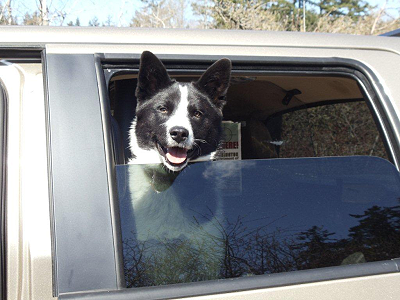
No problems with kids, they’ve been fantastic. Occasionally, they might nip at another dog to just kind of cover his own territory, but they’re great with the public, great with the kids. That’s one of the reasons why we use them. Folks need to understand they cost money, they take time, they take energy, they take training. My dog, in particular, is stubborn, so we got to work through that just a little bit, and we’ll use whistles and food to try to convince him that my way is the right way, if I can.
That’s the kind of negatives that I’m talking about. They take energy, and they cost money, and people need to realize that.
Julie: Tell us about some of your agencies outreach programs that educate the public about the dogs and the challenges that face cougars.
Officer Jones: We’ve got some facebook activity. We’ve got our webpage. Those things are on there, hunter ed classes, the local classes that we give. We often go to different schools and do presentations there.
Specifically, down in King County, where you have a lot of activity where the houses are being built right up into the hillsides, so the officers down there have a lot of work with the local people. But I will tell you that the best thing we do is talk on interviews like this, let folks know that this is an option out there and getting to talk about it.
And then, for me, the local work that I do, just dealing with one neighborhood at a time, seeing my dog, asking me questions about the dog, watching my dog at work, seeing some stuff that he does in the newspaper. That, for me, is the best outreach, dog specific, that we do.
Julie: Walk me through how the dogs interact with the cats. If there’s a problem cat, what happens?
Officer Jones: Keep in mind now, we’ve got, let’s say I wrestle 6 bears and 3 cats a year. I don’t have hundreds and hundreds of animals I’m rolling through. I’ll give you last year’s example which is the most recent one in my mind. September, I get two cats. I set up a trail cam on a trap. Often times, it’s not the cat’s fault. People want to blame the cat. Often times, there are things that the folks are doing, like bears and leaving trash out.
With cats, they do things like this last situation I dealt with in September, where the homeowners didn’t really want the goat up by the house, making noise and digging up the dirt. So they put it down on the back 40, down by a creek bottom and tied it to a tree. In cougar country, that’s probably not the wisest thing to do. The cat, as it turned out, was accompanied by a sub-adult, and she was showing the juvenile the ropes. They found the goat just sitting right there. So they killed the goat, and it’s my job to catch the cat.
At the time, I didn’t know there were two cats, but I had a funny feeling there might have been. We put up trail cams so I could see that once we caught the one cat, there was actually a second cat outside the trap. We ended up catching them both. We caught them one at a time; one on one day, one the next day.
My dog’s job is to address the cat at the scene. I bring my dog down, and I’m doing two things. Number one, I’m introducing my dog to these cats, and I’m letting him know this is something I’m interested in, and he’s going to know that smell. I want to introduce him to the cat, smell that smell. He’ll bark at the cat, and nip at the corners of the cage. He’s just barking at the cat. He’s not being completely aggressive, but the cat clearly is not comfortable with the situation.
Then I dart the cats. I load my dog. I load the cat, and we bring the cat out in the woods. We give him a reversal on the drugs, and that cat starts coming to. There comes a point where we’re going to release that cat. This is just hard release activity.
When we deem the cat’s ready to go, its got a tag in its ear and it looks good to go, we check to make sure there’s no visible injuries. Of course we checked it prior to its coming to, naturally. We open up the gate of the trap, and off that cat goes. My dog has been barking at the cat the whole time and then once we release the cat the dog is — if you would have let the dog go he would chase that cat. At my dog’s age right now, I’m not in a big hurry to let my dog go off harness with the cat right now, so I would keep the dog attached to a harness and a leash. He’s just nipping at that cat, and that cat takes off. That cat’s desire, from what I have seen, to return is very limited.
Julie: So it’s really at the release stage when the dogs are involved, not so much the capture?
Officer Jones: That’s the first half of it, and then we can roll over to the other section and this of course has two problems. When you’ve got an animal that’s dead in a pasture, we’ll go there and decide what it is based on the evidence and based on how he reacts. Do we have a cat? Do we have a coyote?
In the instance of a cat, then it’s going to be my dog’s job to find the cat and to tree the cat. In 16 months of his existence with me, he has not had to find and tree a cat. Now he does do some work with Brian Kertson, the biologist I mentioned earlier, who was in the business of finding these cats and collaring them. My dog would do some work with those hounds and those dogs and in all honesty, it is the houndsmens’ dogs that, at this stage, are doing all the work.
As my dog gets more experience and a little more age to him and understanding and maturity, then he can do some more of that activity. For now because he’s so young, I’m not comfortable letting my dog go after some of these cats just yet.
Julie: Did you care to share a personal story of an encounter with a cougar in the wild, either with or without Indy?
Officer Jones: I’ve had several of them. I get a little bit complacent with the cats. I love the cats, I respect the cats, and I maybe should be a little more respectful and fearful of them than I am. I’m just so used to dealing with them. I enjoy seeing them.
My favorite story dealing with cats, a cougar in particular, is when I first moved to this state, I saw one cross the road up ahead of me. I didn’t quite realize how close it was, and how big it was. I pulled over to the side of the road. I had a different dog with me, it was one of my hunting dogs.
I was just trying to see if my dog could find that cat. Now, I’m coming from Boston where you don’t really see cats around. I’ve never seen one in my life, so I wasn’t really familiar with them. But I was curious.
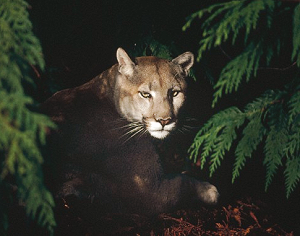
My assumption was that cat had run up the hillside, and I assumed wrong. That cat was right in the bushes probably 15 feet away from me.
When my dog came up to it, he froze like a statue. I was kind of concerned that I bit off more than I could chew. Fortunately, as is typical, that cat was more afraid of me than I was of him, although that was probably a 50/50 push.
After hissing and howling and making a bunch of noise, it went straight up the hillside. That was basically my first interaction with a cougar which was kind of the highlight of my outdoor activity that I enjoy.
Julie: Okay. Well thank you so much David, for taking the time to speak with us today.
Officer Jones: Thank you, Julie. I appreciate the opportunity to try to explain to as many folks as I can what is it that I do as a game warden and what kind of help my dog provides for it.
Julie: The Karelian Bear Dogs are a unique animal, for sure, and I’m so glad to know there are alternatives like this, non-lethal alternatives, that agencies such as yours are utilizing. Fantastic work, David.
Officer Jones: Thank you.
Julie: Thank you so much for sharing what you know about the Karelian Bear Dog. You’ve been listening to a Mountain Lion Foundation On Air broadcast program. Thank you for joining us.
Closing: [music] This has been a Mountain Lion Foundation On Air broadcast. On Air is a copyrighted production of the Mountain Lion Foundation. Permission to rebroadcast is granted for noncommercial use. For more information visit mountainlion.org.
As mentioned during the interview, the dogs can be expensive. Washington’s KBD program is funded entirely by donations from the public.
To help support their work, donations can be mailed to:
WDFW — KBD Fund
16018 Mill Creek Blvd
Mill Creek WA 98012


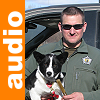

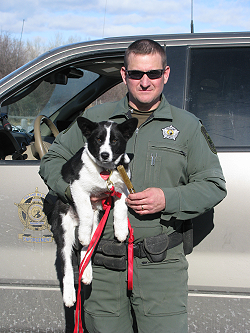

 Facebook
Facebook Twitter
Twitter Send Email
Send Email